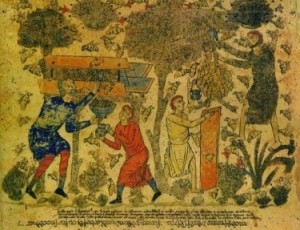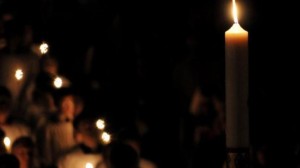THOUGH WE DID NOT HOST AN EASTER VIGIL THIS YEAR DUE TO COVID-19, MINISTRY OF MUSIC JON LACKEY HAS RECORDED THE EXSULTET CHANT. YOU CAN FIND IT ON OUR YOU-TUBE CHANNEL HERE.
BELOW IS A HISTORY OF THE EXSULTET COMPILED BY JON.
A Brief History of the Exsultet Chant
The Exsultet is one of the oldest and most evocative rites of the Christian liturgy and is a central part of the Lighting of the Paschal candle at the Easter Vigil. This year we will be posting the Exsultet on our Easter Vigil Online Service, so look for it there.
Traditionally chanted by the deacon, the Exsultet is sung after the Paschal candle has been lit and the clergy have processed to the altar. The procession and chant have a twofold meaning. They symbolize the journey of the Israelites out of Egypt, as well as the arrival of Christ who is the Savior of the world. The Exsultet recalls for us the history of our salvation; from the fall of Adam, to the events of that first Passover held by Moses and the Israelites, and then finally the events of that last Passover at which Jesus suffered, died, rose from the dead and by which humankind were redeemed. The tone of the hymn is very much one of joy at having received so great a gift as our redemption and eternal life.
According to the Catholic Encyclopedia, the Exsultet originated no later than the late fourth century. Its origin is uncertain, but most religious historians agree that it was written by Saint Ambrose. St. Ambrose (Ambrosius in Latin) (339 – 397 A.D.) was Bishop of Milan, a biblical critic, and initiator of ideas that provided a model for medieval concepts for church-state relations. He is remembered for his literary works, musical accomplishments and especially as the teacher who converted and baptized St. Augustine of Hippo, the great Christian theologian.
The Exsultet was depicted on a liturgical parchment scroll that contained the texts and chants of the Exsultet accompanied by various decorative illuminations related to the contents of the same. In liturgical practice this scroll would be unrolled by the deacon as he sang the Exsultet from it, allowing it to unroll over the ambo (an oblong pulpit in the early Christian church) as he did so, thereby permitting the faithful to see the related iconography as he sang the liturgical text which corresponded to it. A favorite part of the Exsultet for many is the section that refers to bees and bees wax. The picture above of an early scroll of the Exsultet depicts the scene referring to the bees.
As author Father Michael Flynn writes, “For centuries the Exsultet has served as a liturgical jewel of unsurpassed beauty on this, the ‘mother of all holy vigils,’ as St. Augustine aptly described the Easter Vigil. As the Exsultet compels us, ‘Be glad, let earth be glad, as glory floods her, ablaze with light from her eternal King, let all corners of the earth be glad, knowing an end to gloom and darkness.’ May this venerable Easter Proclamation serve us and our assemblies as a genuine expression of Easter hope and joy.”





